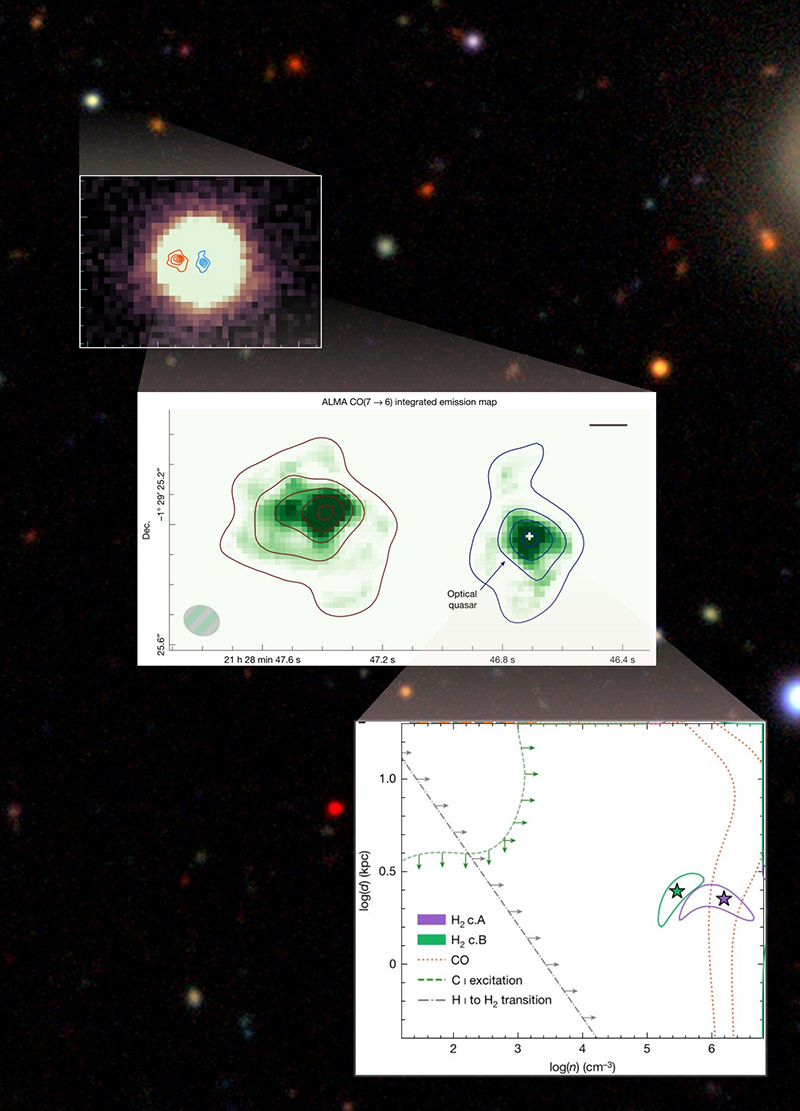A QUASAR LOCATED IN ONE GALAXY TRANSFORMS THE GAS IN A MERGING COMPANION GALAXY
A study jointly led by Sergei Balashev (Ioffe Institute, Saint Petersburg) and Pasquier Noterdaeme (Institut d’Astrophysique de Paris) sheds light on a system of merging galaxies at a redshift of 2.7 (more than 11 billion years ago) and shows that the intense radiation from a quasar profoundly alters the structure of interstellar gas in a neighbouring galaxy. Four other French researchers [J.-K. Krogager (CRAL, Lyon), F. Combes (Paris Observatory), P. Petitjean and A. Omont (IAP)] are part of the international team that conducted the study of this complex system and is publishing the results in Nature.
Quasars are among the most energetic objects in the Universe, powered by the accretion of gas onto supermassive black holes located in the center of galaxies. Growing evidence suggests that galaxy mergers may trigger the birth of these objects by funnelling vast amounts of gas toward galactic centres. In turn, quasars are expected to interact with their surroundings through the tremendous energy they release. However, direct observational evidence of such interactions remains scarce. By combining optical (from UV to near-infrared) and millimetre-wave observations obtained with the VLT and ALMA telescopes, the researchers identified a galaxy interacting with another that hosts a quasar. The galaxies are only a few kiloparsecs apart and are approaching each other at a velocity of over 500 km/s.

Figure 1: The quasar J0125 appears as a point source in optical images (background: DESI, first zoom: Subaru HSC). High-angular-resolution imaging with ALMA reveals that the system is actually composed of two merging galaxies, one of which (on the right) containing the quasar. Absorption spectroscopy with the Very Large Telescope allowed researchers to study the properties of the gas intersected by the quasar’s light (in this case, constraints on density and distance relative to the quasar).
Credit: Pasquier Noterdaeme (IAP).
Since the quasar lies behind the companion galaxy, the researchers were able to analyse the absorption imprinted by the latter in the quasar's spectrum. This reveals extremely dense (𝑛 ≈ 10⁵–10⁶ cm⁻³) and compact (<0.02 pc) gas clouds—much smaller than those typically seen in absorption in intervening galaxies, far from the background quasar. Moreover, the strong excitation of the gas indicates that it is exposed to an extremely intense UV field, about a thousand times stronger than that of the Milky Way. These conditions suggest that the quasar’s radiation dissociates most of the diffuse molecular gas, leaving only regions dense enough to survive the radiation—but too small to form stars.
This discovery provides new insight into the role of galaxy mergers in quasar activity in the distant Universe and reveals a localized feedback process that transforms the internal structure of interstellar gas on scales previously unreachable—100,000 times smaller than what is resolvable in emission! The findings illustrate how quasars, through their intense radiation, can suppress star formation in their immediate environment by restructuring interstellar material.
Links
![]() The scientific article published today in Nature by Balashev et al. (2025), « Quasar radiation transforms the gas in a merging companion galaxy »
The scientific article published today in Nature by Balashev et al. (2025), « Quasar radiation transforms the gas in a merging companion galaxy »
![]() The European Southern Observatory (ESO) press release
The European Southern Observatory (ESO) press release
Writing and contact
- Pasquier Noterdaeme
Institut d’astrophysique de Paris, CNRS, Sorbonne Université
pasquier [dot] noterdaeme [at] iap [dot] fr
Layout: Jean Mouette
May 2025
